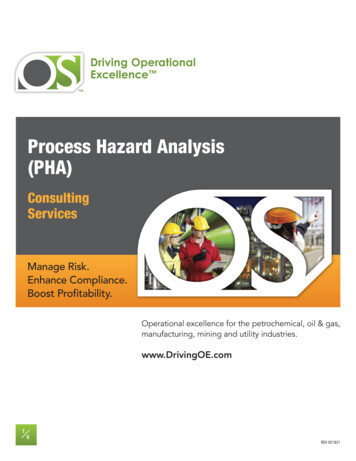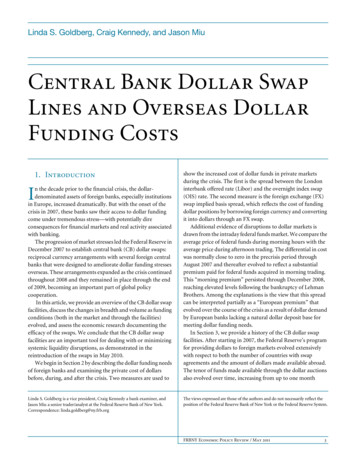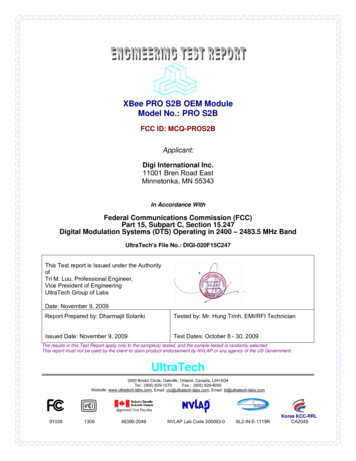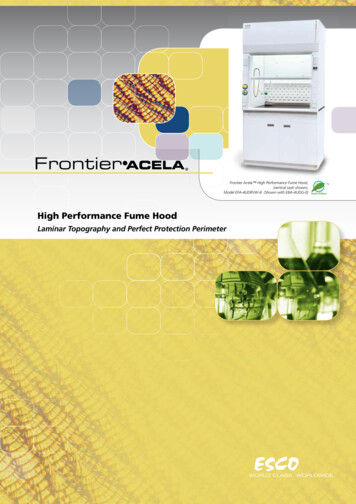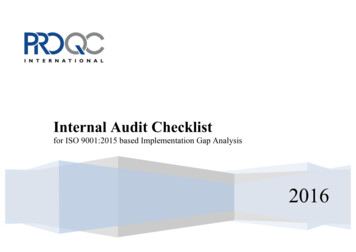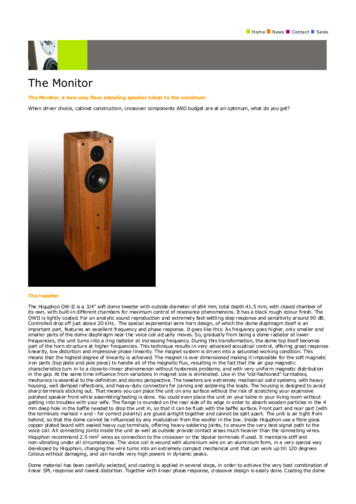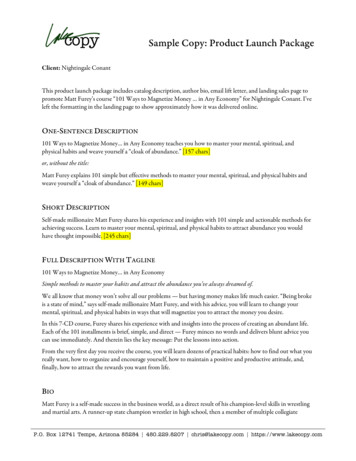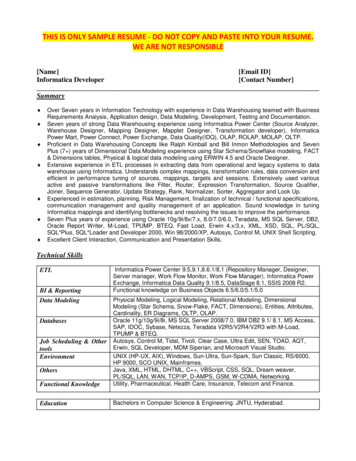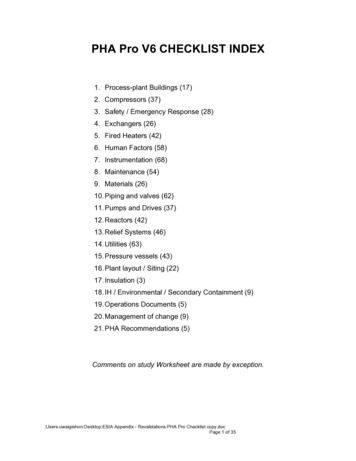
Transcription
PHA Pro V6 CHECKLIST INDEX1. Process-plant Buildings (17)2. Compressors (37)3. Safety / Emergency Response (28)4. Exchangers (26)5. Fired Heaters (42)6. Human Factors (58)7. Instrumentation (68)8. Maintenance (54)9. Materials (26)10. Piping and valves (62)11. Pumps and Drives (37)12. Reactors (42)13. Relief Systems (46)14. Utilities (63)15. Pressure vessels (43)16. Plant layout / Siting (22)17. Insulation (3)18. IH / Environmental / Secondary Containment (9)19. Operations Documents (5)20. Management of change (9)21. PHA Recommendations (5)Comments on study Worksheet are made by exception.:Users:uwaigiehon:Desktop:ESIA Appendix - Revalidations:PHA Pro Checklist copy.docPage 1 of 35
WorksheetSubsystems: 1. Process-plant BuildingsWhat IfRemarks1. Is the structural design sufficient to withstand blast overpressures resulting from credible events (vapor cloud explosions, dust explosions,PV-ruptures, BLEVEs, etc.) in near-by processing facilities without serious personnel injury or damage to safety critical equipment?2. If the building could be subjected to blast overpressures, have windows been eliminated or designed to prevent breakage and injury tobuilding occupants?3. Does the building site meet current company, industry or insurance spacing criteria relative to the hazards of near-by processing or storagefacilities?4. Has the building been designed for credible external events [e.g., earthquake, hurricane, flood, etc.]? Have building impacts from adjacentequipment failures during external events been evaluated [e.g., power loss, falling structures, etc.]?5. For occupied buildings, does the structure include multiple egress routes for personnel in case a fire occurs adjacent to the structure?6. Are building sewer systems segregated from process sewer systems to prevent ingress of flammable or toxic vapors?7. Are large pieces of furniture, equipment, instrument racks, battery racks, and ceiling fixtures adequately anchored in the event of blast orseismic events?8. For multi-story buildings, is heavy equipment located on the ground floor?9. Is equipment located in the building appropriate for the electrical classification of the building and adjacent facilities?10. For occupied buildings, does the building contain adequate numbers and types of personnel protective equipment to handle emergencythat could reasonably be expected to occur?11. For occupied buildings, are evacuation plans clearly posted and reviewed with personnel?12. Is the building equipped with a fire suppression system appropriate the building function and the material/equipment located in thebuilding?13. Has the reliability of critical equipment following a blast, fire, or other external event been evaluated?14. For occupied buildings, has the potential for impacts to occupants from a near-by release of toxic material been evaluated?15. For normally unoccupied buildings where a hazardous atmosphere could develop (such as analyzer buildings), is the building equippedwith gas analyzers, detectors, or some other means to alert personnel entering the building that a hazard exists?16. For occupied buildings that could be subjected to toxic materials, does the HVAC design prevent toxic material ingress to the buildinginterior? Do personnel receive an alarm if the HVAC system is not functioning as designed?17. Is Utility gas for the building odorized?Subsystems: 2. CompressorsWhat If1. Is the compressor casing design pressure greater than the maximum compressor suction pressure plus the compressor shutoff pressure[consider largest impeller(s) when determining maximum compressor differential]? Is this true for each compressor stage?2. Is the downstream piping or equipment design pressure greater than the maximum compressor discharge pressure [consider largestimpeller(s) when determining maximum compressor differential], or is the downstream piping or equipment protected from overpressure in theevent that the compressor is blocked in?:Users:uwaigiehon:Desktop:ESIA Appendix - Revalidations:PHA Pro Checklist copy.docPage 2 of 35Remarks
Subsystems: 2. CompressorsWhat If3. If a downstream blockage would raise the compressor suction pressure, is the downstream piping and equipment rated for the maximumsuction pressure plus the compressor shutoff pressure?4. If a downstream blockage would not raise compressor suction pressure, is the downstream piping and equipment rated for the greater of(1) normal suction pressure plus the compressor shutoff pressure or (2) maximum suction pressure plus normal compressor differentialpressure?5. Has a discharge relief valve been provided for positive displacement compressors?6. Is the compressor adequately protected from damage when operating at low flow rates [determine if minimum flow or anti-surge protectionis required]?7. Is the compressor design temperature greater than the maximum upstream operating temperature? Is the compressor design temperaturegreater than the maximum interstage temperature?8. Is the compressor material selection appropriate for the expected vapor properties, including maximum contaminant concentration?9. For vibrating services, are pulsation dampeners included in the design? Is discharge piping adequately supported? Are branchconnections adequately supported?10. Is the selected mechanical seal appropriate for the intended service, including maximum contaminant concentration?11. Has mechanical seal failure been evaluated?12. Has bearing failure been evaluated?13. Has failure of compressor heat removal equipment (e.g., lube oil coolers, seal oil coolers, and seal flush) been evaluated [consider loss ofcirculation and plugging of coolers]?14. Are compressor "run" indicators (running lights or other process indicators) provided at a continuously staffed location for critical servicecompressors?15. Has the compressor stopping been evaluated?16. Has closing the compressor discharge valve been evaluated? Has closing the compressor interstage discharge valve been evaluated?17. Has liquid carryover to the suction of the compressor been evaluated?18. Has reverse flow through the compressor when it shuts down been evaluated [assume the discharge check valve sticks open]? Hasreverse flow for each compressor stage been evaluated?19. Has compressor over-speed been evaluated?20. If the compressor is provided with minimum flow or anti-surge protection, have failures of the compressor anti-surge control system beenevaluated?21. Has a cooler (e.g., interstage cooler, lube oil cooler, and seal oil cooler) tube leak been evaluated?22. Has operation with higher specific gravity vapor, due to process upset or startup/shutdown, been evaluated [consider whether or not thecompressor is adequately sized for other fluids, such as nitrogen or fuel gas, if the compressor will be required to transfer the other fluidsduring startup or shutdown]?23. Is adequate firewater coverage available for the compressor area?24. Is there adequate emergency access to the compressor?25. Can the compressor be safely isolated in an emergency?:Users:uwaigiehon:Desktop:ESIA Appendix - Revalidations:PHA Pro Checklist copy.docPage 3 of 35Remarks
Subsystems: 2. CompressorsWhat IfRemarks26. If emergency isolation valves (either manual, automatic, or remotely operated) are provided to isolate the compressor, are these valvesappropriate for the process service and valve location [review requirements for fire-rating of isolation valves; fail-safe position of isolationvalves; and fireproofing of valve actuator, power cables, and instrument cables of the isolation valves]?27. If emergency isolation valves are provided, has failure of the isolation valves been evaluated [consider valves closing and valves failing toclose when demanded]?28. For installations where critical service equipment (e.g., air-cooled heat exchangers or power/instrument cables) is located above acompressor handling flammable material, is the critical equipment adequately protected in the event of fire at the compressor [reviewrequirements for fireproofing and installation of fixed water or fixed steam deluge]?29. If fixed water or fixed steam deluge is provided, can the valve or station that actuates the system be operated safely in the event of fire ator near the compressor [consider location of valve/station or the ability to operate valve/station remotely]?30. Have flexible piping components (e.g., hoses, expansion joints, and tubing) been reduced or eliminated where possible? If flexible pipingcomponents are installed, are they designed for maximum operating pressure and temperature? Are flexible connections adequatelyprotected against possible rupture due to mechanical impact and fire?31. Have leaks (at mechanical seal, flanges, etc.) to the atmosphere been evaluated for compressors located in buildings or shelters [concernis for buildup of explosive atmosphere with possible fire or explosion]?32. For compressor installations where minor leaks are known to occur (e.g., mechanical seal, packing, or distance piece leaks), are the leaksvented to a safe location?33. For compressor installations using an engine driver (gas or diesel driven), are the air intake and exhaust lines vented to a safe location?34. Can critical service compressors be quickly shut down from a safe location?35. If emergency isolation valves (either manual, automatic, or remotely operated) are provided, are procedures in place for the routine testingof these valves?36. For critical service compressors, are preventative maintenance procedures in place to reduce the likelihood of equipment failures thatcould result in hydrocarbon or toxic material releases?37. For compressor installations with auxiliary systems (e.g., lube oil, seal oil, vibration, etc.), are alarms and shutdowns routinely tested?Subsystems: 3. Safety / Emergency ResponseWhat If1. Is there a written emergency response plan for this unit that addresses credible emergency scenarios (e.g., toxic material releases, fire,explosions, sabotage, bomb threat, etc.)? Are copies of the written plan readily available to all affected personnel?2. Does the emergency response plan include an incident command structure (or other authority and communication structure) that outlinespersonnel responsibilities during emergency situations?3. Does the emergency response plan specify evacuation routes and personnel assembly or refuge areas?4. Does the emergency response plan contain emergency notification requirements, including a list of contact names and phone numbers, forboth company and outside responders? Is this list up-to-date?5. Does the emergency response plan identify essential personnel who must remain on-site during an emergency [confirm that a sufficientnumber of trained people who are knowledgeable in the hazards of the process and emergency response are available at all times, either onsite or via rapid call-out]?:Users:uwaigiehon:Desktop:ESIA Appendix - Revalidations:PHA Pro Checklist copy.docPage 4 of 36Remarks
Subsystems: 3. Safety / Emergency ResponseWhat If6. Does the emergency response plan identify the resources (personnel and equipment) available from outside sources (i.e., community firedepartments, mutual-aid partners, etc.)?7. Does the emergency response plan include procedures to account for all personnel following an incident, including employees, contractors,and visitors?8. Do procedures specify proper response to warning sirens, whistles, or horns? Are these warning devices routinely tested?9. Does the emergency response plan specify which communication channels are restricted for use by emergency responders during anincident?10. Does the emergency response plan include provisions for off-site traffic control and access for off-site responders?11. Does the emergency response plan specify the reporting requirements for the various incidents that may occur at the facility, includingreporting to facility and company management as well as to outside agencies?12. Has an incident command center, stocked with necessary reference information (e.g., emergency response plan, site and communitymaps, call-out lists, etc.) and communication systems been established? For large facilities, is this information available at multiple locations?13. Are hypothetical emergency drills routinely conducted? Do outside sources (i.e., community fire departments, mutual-aid partners, etc.)participate in the hypothetical drills? Are procedures in place to critique the response to hypothetical drills and resolve the recommendationsfrom these reviews?14. Is a program in place to verify all affected personnel receive initial and refresher training in the emergency response plan? Is the refreshertraining provided on an annual basis and whenever updates to the plan are made?15. Has the adequacy of the outside agency response program been evaluated [consider familiarity with the hazards of the process,knowledge on how to respond to emergency situations, physical condition of outside agency members, etc.]? Has the adequacy of theoutside agency equipment been evaluated [consider availability and adequacy of fire-fighting equipment, including foam, adequacy andintegrity of personnel protective equipment, and amount of equipment available]?16. Do procedures specify the method and frequency for inspection, maintenance, service, and testing of emergency response equipment(i.e., fire suppression and extinguishing systems, personnel protective equipment, etc.)?17. Is detection/alarming equipment for fire or flammable gas tested regularly and maintained in functional condition?18. Are open safety recommendations valid?19. Are open safety recommendations being addressed in a timely manner?20. Are open Incident Investigations being completed in a timely manner?21. Are recommendations being addressed promptly?22. Is lighting adequate?23. Is emergency lighting adequate?24. Are safety showers and eyewashes adequate in location and performance?25. Are safety shower lights adequate?26. Does th
:Users:uwaigiehon:Desktop:ESIA Appendix - Revalidations:PHA Pro Checklist copy.doc Page 1 of 35 PHA Pro V6 CHECKLIST INDEX 1. Process-plant Buildings (17) 2. Compressors (37) 3. Safety / Emergency Response (28) 4. Exchangers (26) 5. Fired Heaters (42) 6. Human Factors (58) 7. Instrumentation (68) 8. Maintenance (54) 9. Materials (26) 10. Piping .
